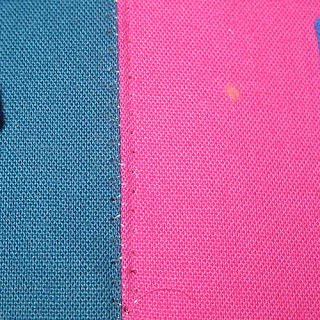Here's a colorful table topper, made with a wild range of fabrics - some have been in my stash for 20+ years, and some are hot new Kaffe, Westminster and Tula Pink prints. It's 23" across the center.
It's English Paper Pieced (EPP), with the help of acrylic templates from Sewing By Sarah. One example from the 12 piece set:
(Full disclosure - I was paid a lump sum for the design and directions for this tabletopper. Sewing by Sarah also distributes my free guide to EPP, which you can download here. I do NOT receive a percentage of sales for any of these items.)
My table topper has the traditional "Seven Sisters" arrangement, with six hexagon blocks circling a seventh. I hand-stitched a couple of them with regular thread; I stitched the rest by machine using monofilament invisible thread on top. EPP by machine is much MUCH faster than doing it by hand.
1. First, a traditional star (made with Kaffe Fasset prints):
2. Next, the identical block layout, but with values manipulated so you see three cubes instead of a star. And speaking of seeing, the eyeballs are a way-cool Tula Pink print. The black + color fabric is an oldie from my stash.
3. The block below also creates an illusion of floating cubes, two of them.
4. This block looks more complicated than it is, because I used busy large-scale prints, cut from 5" charm squares, for the three interior hexagons:
4. More trendy prints:
5. In this block, the busy colorful print is from the 1970s, but the outer white diamonds are brand new. The green fabric is in-between, age-wise; I think I bought it in the 90s.
7. For the last block, I manipulated values - light on top, dark below, medium to the side - to create the illusion of a single cube.
Along with those six hexagon blocks, I made some random blocks, for an undetermined future project. A pentagon-shaped block:
I call this "Star Hive;" a modified six-pointed star with little floral viruses nesting in the nooks, and three tiny eyeball points.
Acrylic rotary cutting templates are very helpful if you want to fussy-cut pieces, like the flowers in the block above. You can mark the top of the template with a waxy crayon or china marker, tracing prominent designs in the fabric, so you can easily locate and cut more identical pieces.
Everything outside the seam allowance won't show in the finished block.
The basting papers can't be made from the rotary cutting templates. The booklet I wrote to go with them includes full size diagrams to download and print, like this one.
Cut the diagram apart and there are your basting papers. You can stitch-baste the fabric over the paper templates by hand, on planes, trains, and dentist offices, for example. But when I'm home, I glue-baste at the ironing board, saving an immense amount of time. Place the template-cut fabric on the back of a paper template, and use little dabs of temporary school glue to fold, press and hold the edges inward.
In this photo, I laid out the paper templates for the surrounding pieces (I had to use blue cardstock because I lost one printed template.)Here's a triangular plastic template that I used to audition locations, just before cutting. (I used blue painter's tape to make my own notes about size.)
The finished block:
It has 10 sides.. I don't know how to fit 10-sided blocks together, but this can be appliquéd to a background! Here's another 10-sided block, which features matzoh fabric. (There's always room for matzoh!)
Stitched to a background (and pressed well!) Yes, you saw this wedding gift before.
If you're interested in learning more about the Sewing by Sarah acrylic template set, it's here. My free downloadable EPP guide is here.




















































